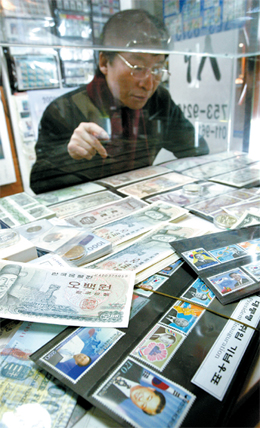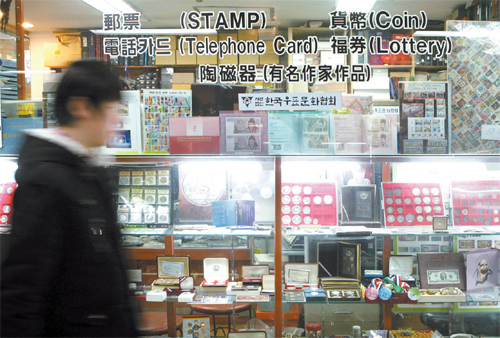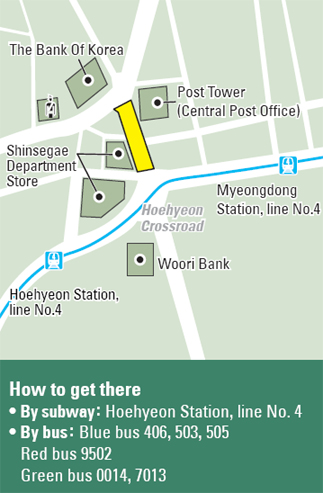Rare stamps and old-world charm

Back in those days, long lines resembling a celebrity autograph event formed in front of post offices every time the government issued a new stamp.
It’s fair to say that stamp collecting has lost some of its appeal over the years, so it’s no surprise that Hoehyeon stamp shopping center, a mecca for stamp collectors in Korea, looks like it’s seen better days.
Adjacent to the colossal main branch of Shinsegae Department Store in downtown Seoul, the underground arcade today looks worn out.
Connecting Shinsegae Department Store and Seoul’s central post office in Myeong-dong, it’s home to 17 antique stamp and antique coin stores plus shops selling used vinyl LPs and casual clothing.
At the stamp stores you can buy stamps [of course], old banknotes and coins. But it’s not just old stuff for sale. You can also get hold of lottery tickets, telephone cards and even maps.
Kim Dan, who runs Samseong Stamps in the underground arcade, was one of those kids back in the 1970s. He was a fanatic about getting his hands on the rarest stamps he could find.
“In the 1970s and 1980s, stamp collectors were mostly kids,” Kim said. “But now, hardly any kids visit my store. The people who buy now are mostly adults who collected during their childhood or collectors who want to sell their stamp collections,” he said.
If you are still obsessed with collecting postage, the Hoehyeon underground is a place you should visit. There you can find just about every stamp, banknote and coin ever issued in Korea. Prices range from a few hundred won to more than 5 million won ($3,457).
“I come here once every two or three months,” said Park Dae-hyeon, 19, a student. He said his father, an enthusiast in his youth, inspired him to start stamp collecting.
“There are almost no other stamp stores in Seoul except for here,” Park said, explaining that he has learned much about Korean history from the stamps, the “things that you can’t learn in school.”
The stores started to cluster in this neighborhood during the 1980s because of its proximity to the central post office. The underground arcade started leasing out shops around that time as well.

The stamp stores of Seoul’s Hoehyeon underground shopping arcade have seen fewer customers since the 1997-98 Asian financial crisis. By Oh Sang-min
Korea first started issuing stamps in 1884 when Hong Yeong-sik, a government official, came back from Japan to start Korea’s first modern postal service. The Korean Stamp Association was formed in 1949 to promote knowledge about stamps and the postal service in general.
These days even new collections fail to excite veteran collectors. Korea Post, under the Ministry of Knowledge Economy, announced last year that it plans to issue 53 new stamps this year. Chun Hu-sik, the owner of World Stamps in the arcade, was unmoved, since so few people collect anymore.
Although the antique stamps industry has gone downhill in recent years, the global economic slowdown hasn’t really impacted Chun’s business because stamp collecting isn’t influenced too much by the economy.

Enthusiasm for stamp collecting started to die down after the Asian financial crisis, around 1997 and 1998, he went on. Back when stamp collecting was popular, his store sold many more stamps than banknotes or coins but now, as demand for stamps has fallen, the situation has reversed.
Some of the stamps and coins in Chun’s cramped store date back to the 19th century. One of the most sought after banknotes is the 1962 “mother-son” bill, which was used for only 24 days before it was discontinued after Korea’s third currency reform that year.
“It [the ‘mother-son’ bill] is a must-have for rookie collectors,” said Chun. But it will cost you. At Samseong Stamps the bill costs around 4.2 million won.
Another popular item for collectors is the “Moon” series, Korea’s first stamp series, which was issued in November 1884 when Korea opened its first modern post office.
It is one of the nation’s rarest stamps. Within a month of its launch, a coup to overthrow the Joseon Dynasty led to the government abandoning the series.
Hachikubo Koshi, a geography professor at Kanagawa University in Japan who was visiting the store last week, said he is an avid stamp collector and has many Korean stamps from the Park Chung Hee administration.
As he was haggling with Chun over the price of some Seoul Olympics stamps, he said, “Korean stamps are very popular with Japanese stamp collectors because of our interlocking history.”
The stamp store owners in the underground arcade say the most popular stamps, past and present, commemorate the inauguration of new presidents, in particular stamps celebrating the presidencies of Syngman Rhee and Park Chung Hee.
These days, Dokdo stamps are also selling well. Prices have jumped tenfold in three years.
The price of antique stamps or money fluctuates for many different reasons, but store owners say the condition of an item plus its relative rarity are key factors affecting prices.
For example, Kim said a coin from the Joseon Dynasty (1392-1910) could go from 10,000 won to 250,000 won depending on its condition and whether it had been used or not.
Park says he sometimes feels like a “weirdo” because he is so keen on stamp collecting, but that this won’t stop him. “It’s the most tangible, fun way to remember Korea and all its historic irony,” he said. “Stamps show the dynamics of a country in the smallest possible size - everything from its culture, politics to economic tides.”
By Cho Jae-eun Staff Reporter[jainnie@joongang.co.kr]
Glimpse of Business in Seoul
Seoul’s Bangsan wallpaper area weathers crisis
Weaker won creates glasses spectacle
Sadang brims over with top furniture bargains
Rare stamps and old-world charm










with the Korea JoongAng Daily
To write comments, please log in to one of the accounts.
Standards Board Policy (0/250자)